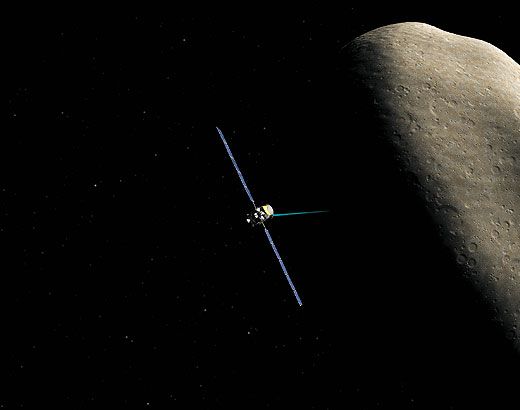Destination: Asteroid
After four years of spiraling out from Earth, the Dawn spacecraft closes in on its first target.
/https://tf-cmsv2-smithsonianmag-media.s3.amazonaws.com/filer/JJ11-DAWN-to-Asteroids-FLASH.jpg)
We’ve seen asteroids up close before, but none like these two. “These aren’t little chips of rock. We’re talking about charting the last unexplored worlds in the inner solar system.” So says Marc Rayman of NASA’s Jet Propulsion Laboratory in California, the chief engineer and mission manager for Dawn—the first mission to probe the mysteries of the main belt asteroids, located between Mars and Jupiter.
Other spacecraft have visited asteroids closer to Earth, and a few have swept past main belt objects on their way to somewhere else. But none has stayed for a thorough, close investigation. Dawn will. Nearly four years after its September 2007 launch, with only half its xenon propellant expended, the $266 million spacecraft is finally nearing the first of its two targets, the enigmatic asteroid 4 Vesta.
To the scientists looking at data sent from the spacecraft over the past few months, the images of the 330-mile-wide asteroid have grown in size and brightness as Dawn closes in at a relative velocity of 1,500 mph. By early June, Dawn’s camera will be close enough to take pictures of Vesta that surpass even Hubble’s best shots.
Pushed by a steady stream of ionized xenon gas—the low-thrust propulsion that makes this multi-target mission possible—the spacecraft will match orbits with Vesta in late July. As the relative velocity slows to 110 mph about 9,900 miles out, Vesta’s weak gravitational field will swing Dawn into a looping 10-day orbit over the asteroid’s poles. Another month of gentle ion thrust will spiral the orbit down to within 110 miles of the surface. By then the Dawn imager will resolve details on Vesta as small as 25 feet, while a visible and infrared spectrometer maps the asteroid’s mineral composition.
Both of Dawn’s targets are big (600-mile-wide Ceres was recently re-classified as a dwarf planet, like Pluto), and both were discovered more than 200 years ago. But we still don’t know much about them.
For Dawn’s international science team (the framing camera is German-built; the imaging spectrometer, from Italy; the nuclear spectrometer, from Los Alamos, New Mexico), the mission is like traveling back to the era of planet formation, 4.6 billion years ago. The Dawn researchers hope to learn more about the physical and chemical processes that gave rise to the rocky inner planets. These two remnant “planetesimals” should provide clues to the violent collisions that shattered nearly every other large object in the asteroid belt, producing some of the building blocks of Earth and its neighbors.
One puzzle Dawn should help to solve is why these two neighboring worlds took such different evolutionary paths. Vesta underwent extensive melting and differentiation, while Ceres, just a bit farther from the sun, stayed cool enough to preserve water ice in its interior even today.
Luckily for scientists, they already have pieces of Vesta—in the form of some 200 “HED” (Howardite-Eucrite-Diogenite) meteorites whose spectral signatures closely match that of Vesta. Shortly after its formation, more than 4.5 billion years ago, the asteroid underwent severe heating, probably from the decay of radioactive elements. A fluid mantle formed, and thick layers of basaltic lava erupted onto the surface. As Vesta cooled, it was pummeled by other asteroids, including one collision that blasted out a gigantic crater about 290 miles across. Hubble images show how this impact sheared off Vesta’s south pole, a cataclysm that sent fragments wandering all the way to Earth. Says Dawn team member and asteroid scientist Lucy McFadden, “Dawn should give us some perspective on that great impact basin, as well as other suspected craters that may have punched through to reveal Vesta’s interior.”
After a year studying Vesta, Dawn will use its ion engine to spiral up and out of orbit, becoming the first spacecraft to orbit one solar system body, then leave to orbit another. It should reach Ceres in 2015, where it will confront another mystery. Orbiting almost three times Earth’s distance from the sun, Ceres probably incorporated large amounts of water ice during its formation. Ground-based observations still show water trapped inside clay minerals on the asteroid’s surface, and models suggest that Ceres harbors a layer of ice or even liquid water beneath its solid crust.
During this six-month phase of the mission, Dawn co-investigator Mark Sykes will be looking, he says, for “signs that interior water is escaping onto Ceres’ dark surface. If we find indications of a subsurface ocean, it may exhibit the right chemical and thermal conditions for life. And then Ceres becomes an astrobiological target for exploration.” In other words, a place to look for signs of life.
The notion of a watery Ceres raises one last intriguing possibility. We won’t be sending astronauts there anytime soon, but the object’s water-rich splinters—which roam the inner solar system as near-Earth asteroids—could furnish propellants for future astronaut and robot expeditions. Dawn’s first close look at Vesta and Ceres, says Sykes, “takes asteroids out of the ‘Chicken Little’ realm”—where they’re seen only as threats—and enables us to picture using them someday as resources that “can leverage our future beyond Earth.”
Former astronaut Tom Jones would still like to head an expedition to an asteroid, but takes comfort in the certainty that asteroids are surely coming to us.
